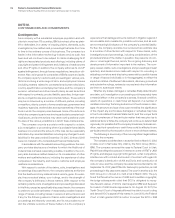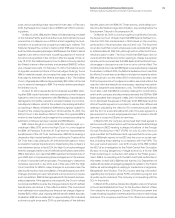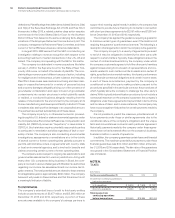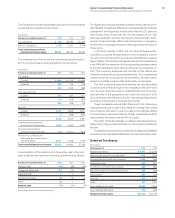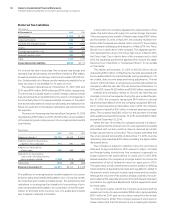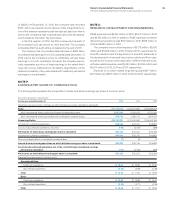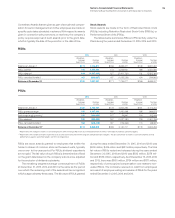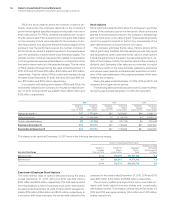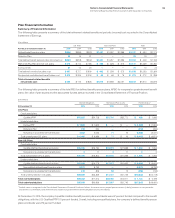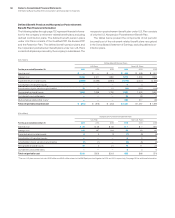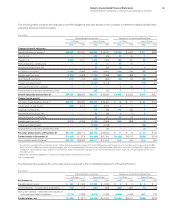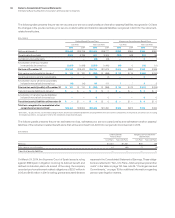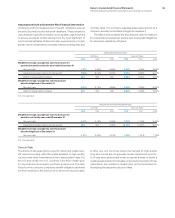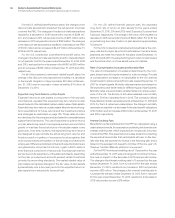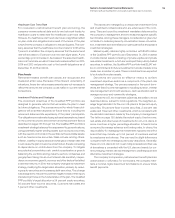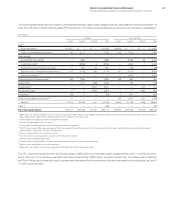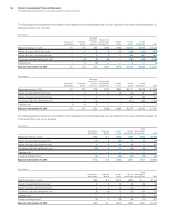IBM 2015 Annual Report Download - page 130
Download and view the complete annual report
Please find page 130 of the 2015 IBM annual report below. You can navigate through the pages in the report by either clicking on the pages listed below, or by using the keyword search tool below to find specific information within the annual report.Notes to Consolidated Financial Statements
International Business Machines Corporation and Subsidiary Companies
128
The company’s matching contributions vest immediately and
participants are always fully vested in their own contributions. All
contributions, including the company match, are made in cash and
invested in accordance with participants’ investment elections.
There are no minimum amounts that must be invested in com-
pany stock, and there are no restrictions on transferring amounts
out of company stock to another investment choice, other than
excessive trading rules applicable to such investments. Effec-
tive January1, 2013, matching and automatic contributions are
made once annually at the end of the year. In order to receive
such contributions each year, a participant must be employed on
December15 of the plan year. However, if a participant separates
from service prior to December15, and has completed certain ser-
vice and/or age requirements, then the participant will be eligible
to receive such matching and automatic contributions following
separation from service.
IBM Excess 401(k) Plus Plan
The IBM Excess 401(k) Plus Plan (Excess 401(k)) is an unfunded,
nonqualified defined contribution plan. Employees whose eligible
compensation is expected to exceed the IRS compensation limit
for qualified plans are eligible to participate in the Excess 401(k).
The purpose of the Excess 401(k) is to provide benefits that would
be provided under the qualified IBM 401(k) Plus Plan if the com-
pensation limits did not apply.
Amounts deferred into the Excess 401(k) are record-keeping
(notional) accounts and are not held in trust for the participants.
Participants in the Excess 401(k) may invest their notional accounts
in investments which mirror the primary investment options
available under the 401(k) Plus Plan. Participants in the Excess
401(k) are also eligible to receive company match and automatic
contributions (at the same rate as under the 401(k) Plus Plan) on
eligible compensation deferred into the Excess 401(k) and on
compensation earned in excess of the Internal Revenue Code
pay limit once they have completed one year of service. Amounts
deferred into the Excess 401(k), including company contributions
are recorded as liabilities in the Consolidated Statement of Finan-
cial Position. Effective January1, 2013, matching and automatic
contributions are recorded once annually at the end of the year.
In order to receive such contributions each year, a participant
must be employed on December15 of the plan year. However, if
a participant separates from service prior to December15, and
has completed certain service and/or age requirements, then the
participant will be eligible to receive such matching and automatic
contributions following separation from service.
Nonpension Postretirement Benefit Plan
U.S. Nonpension Postretirement Plan
The company sponsors a defined benefit nonpension postretire-
ment benefit plan that provides medical and dental benefits to
eligible U.S. retirees and eligible dependents, as well as life insur-
ance for eligible U.S. retirees. Effective July1, 1999, the company
established a Future Health Account (FHA) for employees who
were more than five years from retirement eligibility. Employees
who were within five years of retirement eligibility are covered
under the company’s prior retiree health benefits arrangements.
Under either the FHA or the prior retiree health benefit arrange-
ments, there is a maximum cost to the company for retiree health
benefits. Effective January1, 2014, the company amended the plan
to establish a Health Reimbursement Arrangement (HRA) for each
Medicare-eligible plan retiree, surviving spouse and long-term
disability plan participant who is eligible for company-subsidized
coverage and who enrolls in an individual plan under the Medi-
care Exchange. The company also amended its life insurance plan.
Employees retiring on or after January1, 2015 are not eligible for
life insurance.
Since January1, 2004, new hires, as of that date or later, are
not eligible for company-subsidized nonpension postretirement
benefits.
Non-U.S. Plans
Certain subsidiaries and branches outside the United States spon-
sor defined benefit and/or defined contribution plans that cover
eligible regular employees. The company deposits funds under
various fiduciary-type arrangements, purchases annuities under
group contracts or provides reserves for these plans. Benefits
under the defined benefit plans are typically based either on years
of service and the employee’s compensation (generally during a
fixed number of years immediately before retirement) or on annual
credits. The range of assumptions that are used for the non-U.S.
defined benefit plans reflect the different economic environments
within the various countries.
In addition, certain of the company’s non-U.S. subsidiaries
sponsor nonpension postretirement benefit plans that provide
medical and dental benefits to eligible non-U.S. retirees and eligible
dependents, as well as life insurance for certain eligible non-U.S.
retirees. However, most non-U.S. retirees are covered by local gov-
ernment sponsored and administered programs.


